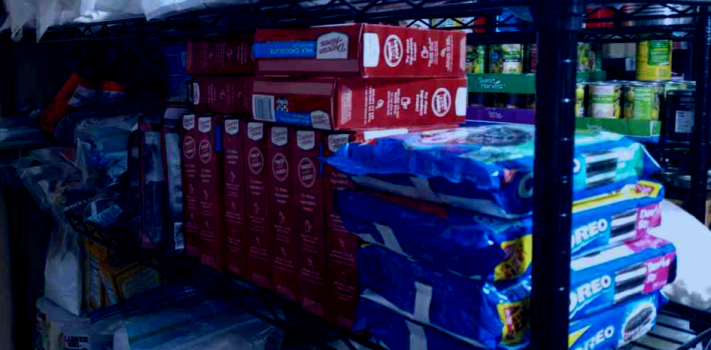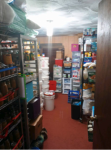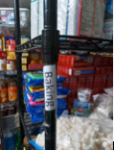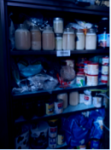Organizing one’s pantry is generally part of the list of items we know we should do, like eating right, getting in shape, de-cluttering the closets, and cleaning out the basement. But organizing our food stock doesn’t need to be a depressing chore. I want to share with you what has worked well for me so that (hopefully) it will motivate you to attack your pantry with success in sight!
I have added pictures not only to assist in the explanation but to add some appeal to an otherwise boring topic.
To some, a pantry may seem like an old-fashion term- something our grandma had at the old farmhouse. To some it may seem useless with the ability to easily obtain food through personal shopping, or apps like Grubhub and Doordash. But to those of us in the prepper world, a pantry may mean an entire room stocked from floor to ceiling with enough supplies to feed the neighborhood. Whatever your pantry looks like, here are some tips on how and why and to organize it!
Pantry Placement
The placement of the pantry within your home is important. Of the factors to consider, ask yourself these questions:
Question #1-Is it close to my kitchen? Having a pantry in the furthest room from your kitchen may help you get your daily steps in, but can also be frustrating and exhausting.
Question #2- Where do I have room? If you are limited on space, you may want to consider storing under furniture like beds. They make plastic storage tubs specifically for under the beds. Look for other wasted areas where you can safely store and easily access pantry items.
Question #3-Is it in an area that is cool and dry as possible? Our pantry is right outside of the utility/laundry room and sometimes in the winter we open up the dryer vent to add moisture to the family room. But when we do this, we make sure that the door to the pantry is tightly closed. For those who live in temperate climates, a garage may work as a pantry. But for those that live in areas that have temperatures that swing more than monkeys at the zoo, the only thing to consider storing in the garage might be toilet paper!
Question #4- Is there room to expand it, as needed? When I first started expanding my food supplies, I set up a set of shelves in the utility/laundry room. After a few years and adding as many shelves as I could possible fit in the room, I decided to turn the spare bedroom which was located directly across from the utility room into a grand-sized pantry.
Question #5-Can it be somewhat secured from prying eyes? The answer to this question may be the wrong answer to question #1. Placing your pantry in the room no one ever goes to might be good for operational security (OPSEC), but that may be the room that is furthest from your kitchen. You decide. If your pantry consists of only a few shelves of extra food, then it should do no harm for others to see it. If you have an extensive pantry- one that takes up a complete room- then discretion is prudent.
Shown is our prepper pantry that is located on the lower level off of the utility room:
WHY ORGANIZE?
Organization in the pantry is useful for several reasons, the chief reason being that you will know what you have. This will save you money so that you aren’t stocking up on items you already have plenty of. I recently organized my pantry only to find that I had more than 2 brownie mixes left. In fact, I had a total of nine! Maybe that wasn’t a good example…can you ever have too many chocolate items- especially when the world is falling apart? ☺
Secondly having an organized pantry will save you time searching for items. It will also save your family members’ time searching for items!
USING LABELS
I am a strong believer in labels. Even when I only had a five-shelf unit in the utility room, I labeled the shelves so EVERYONE could tell what was where. This not only relieves some of the frustration and the yelling, “MOM, I CAN’T FIND IT!” but also saves me from always being the one who has to make the trip to the downstairs pantry for supplies.
When attaching your labels, find a place that is easily read by all who might be looking for something. I made labels by printing them on the computer and using clear packing tape (holds better than regular tape) and tape the labels onto one of the upright poles, as shown:
CATEGORIES
As far as labels, the next question I get from others is this: What are the categories? These can vary from person to person. For example in our pantry I have a meat section but a vegetarian wouldn’t have this. So these are the categories that work for us: drinks, fruits, vegetables, poultry and pork, tomato, baking, toiletries, soup and condiments, and medical supplies.
Vegetables:
Everything that is considered a vegetable can be found in this area. I try to keep similar veggies together- all corn together, all pumpkin together, etc. Although this is one of my smaller shelving units, I still have quite a few cans and jars. And quite the selection! It is not uncommon for me to buy a case (12 cans) of a vegetable that is on sale throughout the year. Generally, the “on-sale” cans go for 87 cents and I think that is a good buy!
Tomato:
Since everyone and every family probably has different eating habits, your labels should reflect how and what your family eats. Our family enjoys different pasta dishes, so I began with a shelf/shelving unit labeled “TOMATO”. Everything from tomato puree, to sauce, to diced tomatoes, to spaghetti sauce can be found in this area. What I do not place in this area is catsup, since I have a separate area for condiments.
Poultry and Pork:
In years past I have loaded up on turkeys when they were on sale for 50 cents a pound (at Thanksgiving time). I would normally purchase 10-12 very large turkeys and store them in one of my freezer until I found the time to can them. But this year I only purchased 2 due to the price increase and because we have started raising our own meat chickens. So there are many shelves with both store-bought poultry and home raised poultry, as well as jars of stock/broth.
Also in this area you will find multiple bottles of Alfredo sauce because chicken and Alfredo just go together in this family. And to top it off (literally) I store plastic containers of parmesan cheese ☺
On the top of the poultry unit, we have a shelf of canned pork. We enjoy eating this meat but don’t raise pigs yet so we do not have an abundance of pork canned. When pork is on sale I will purchase roasts and can those for future use.
Fruit:
In the fruit section of my pantry you will find both store canned fruit such as pineapple (haven’t learned to grow the stuff in the midwest yet) and fruit cocktail, and many jars of home-canned fruit. Peaches, apples, cherries, homegrown blackberries, pears, and grapes are stored here. This is also where I keep our homemade jams and jellies and the home-canned pie fillings. It is so refreshing and convenient when someone calls at the last minute to invite us to dinner and I offer to bring dessert… and I only need to go to the pantry for a full selection of choices!
As a subdivision of the fruit area, I have breakfast items on the top shelves. Items such as oatmeal, cereal, Poptarts, and pancake mixes don’t warrant their own area in this household.
Baking Section:
I enjoy baking so this section is always full and contains a variety of items. This is where I keep my shorter-term basics like flour, sugars- both white, brown, and powdered, shortening and other oils, spices, and cornmeal. I keep additional sweeteners like molasses, honey, and maple syrup here. (I have another pantry on our property where we have our longer-term storage foods- those with 20+ year shelf life or items that have been sealed for long-term storage.) I store yeast and Jello and crackers- both graham and saltine- in this area. Some have asked, “How much flour and sugar do you keep close on hand?” I try to keep 20 pounds of each- flour, white sugar, brown sugar, and 10 pounds of powdered sugar in my pantry. This may seem like a lot but remember, I do a lot of baking. Plus, having enough room to store this much isn’t a problem when your pantry is the size of a bedroom!
On my Baking Shelving Unit, is the most important shelf…MY CHOCOLATE SHELF. This is where I keep brownie mixes, chocolate cake mixes (the other cake mixes are on this unit but on another shelf), chocolate chips, cocoa powder, and Oreos! Who could face the end of the world without chocolate!
Drinks:
I have a shelving unit that is mostly for drinks- anything from coffee, to tea, to drink mixes, to canned and powdered milk, evaporated and condensed milk. I also keep extra creamer and fruit juices here.
Because this unit sits across from my vegetable unit, I have a few overflow cans of beans. As space becomes available on the veggie unit, they will make the trip to the appropriate unit!
Soups and Condiments:
I have one shelving unit that holds more than just condiments. But condiments are found here — and this includes more than just mustard and catsup. There is mayonnaise, salad dressings, enchilada sauces, BBQ sauces, and hot sauces.
On another shelf on this unit is where I keep our soup selection. Although most of our soups are homemade, I do keep store-bought cans of certain soups (Creams of mushroom, chicken, and tomato) here as well as long term storage dried soup mixes.
On the top shelf I keep my Food Saver machine and my spare dehydrator. These are useful but not used as often to warrant a lower shelf.
On the bottom of this unit I keep cleaning supplies – only because I couldn’t figure where else to put them. I generally only have bleach, dishwasher soap and dishwashing liquid, and some disinfectants such as wipes and Lysol-type of cleaners. [JWR Adds: Beware of any cleansers that can out-gas and taint foods stored in soft packages. Generally, cans will be safe from intruding fumes. But one exception is plastic bleach jugs, which can induce rust on nearby cans.]
Personal Hygiene Items:
On this unit, you will find most items you will use in the bathroom- toilet paper, toothpaste and brushes and floss, feminine hygiene products, soap in both liquid and bar form. I keep some infant/children items here such as wipes and Pedialyte and infant Tylenol. Also in this area, I have stored non-disposable hygiene items like family cloths and cloth pads for use during TEOTWAWKI. Although the idea of using non-disposable family cloths or washable sanitary napkins may be repulsive to some, the idea of not having anything to use is even worse!
Medical Items:
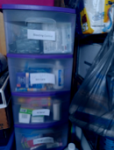
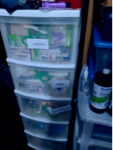 I keep a good supply of over-the-counter (OTC) drug items on hand — for aches and pains, indigestion, cough and colds. This is the hardest area for me to keep rotated as far as “use-by dates” and first in-first out procedures. Although I am not a pharmacist or a doctor, I have been told by many that (MOST) medicines will not turn to poison when they are past their expiration date. So far, I have found this to be true. But if you find medicines that are past their “use by” date, contact your physician for advice. Because I have a background in pre-hospital emergency medicine I have an extensive selection of first aid items. I have suture kits, different types of trauma dressings, multiple tourniquets, and Quik-Clot for bleeding control. Friends have given me sterile dressings, needles, and syringes that they no longer need. Anytime a friend or family member is done using items like soft splints or crutches, I ask for them and these items get stored with the medical supplies.
I keep a good supply of over-the-counter (OTC) drug items on hand — for aches and pains, indigestion, cough and colds. This is the hardest area for me to keep rotated as far as “use-by dates” and first in-first out procedures. Although I am not a pharmacist or a doctor, I have been told by many that (MOST) medicines will not turn to poison when they are past their expiration date. So far, I have found this to be true. But if you find medicines that are past their “use by” date, contact your physician for advice. Because I have a background in pre-hospital emergency medicine I have an extensive selection of first aid items. I have suture kits, different types of trauma dressings, multiple tourniquets, and Quik-Clot for bleeding control. Friends have given me sterile dressings, needles, and syringes that they no longer need. Anytime a friend or family member is done using items like soft splints or crutches, I ask for them and these items get stored with the medical supplies.
I have elastic bandages and adhesive stretch wrap as well as items like triple antibiotics and larger bandaids. I can’t perform surgery with what I have, although I should be able to keep you alive until you get to the hospital!
These pre-hospital items are in clear tubs with large labels so that anyone can retrieve what is needed quickly.
Literature:
 I have three short shelves for books- some are for our grandchildren when they get a bit older, but most of them are reference books regarding homesteading, survival skills, and livestock care. I have notebooks of articles that I have printed off of reputable websites that will come in handy should the worldwide web not be available.
I have three short shelves for books- some are for our grandchildren when they get a bit older, but most of them are reference books regarding homesteading, survival skills, and livestock care. I have notebooks of articles that I have printed off of reputable websites that will come in handy should the worldwide web not be available.
The Rolling Rack
I have a small rolling baker’s rack that I made shelves for that holds over-the-counter vitamins and dietary supplements. These are arranged in alphabetical order for ease of locating what I need.
Buckets
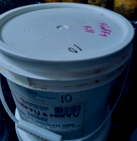 I started out filling buckets with dry goods (rice and beans) and still use these. But I have moved some of the buckets sealed for long-term storage to another area of our farm. As you can see, some still remain in the house pantry. These I mark with permanent marker- both on the side and the top of the bucket or ease of reading. Then I keep a separate inventory list of the contents of each bucket.
I started out filling buckets with dry goods (rice and beans) and still use these. But I have moved some of the buckets sealed for long-term storage to another area of our farm. As you can see, some still remain in the house pantry. These I mark with permanent marker- both on the side and the top of the bucket or ease of reading. Then I keep a separate inventory list of the contents of each bucket.
INVENTORY
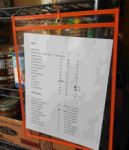
 No pantry should be without an inventory list. It is easier to create the list at the beginning of organizing your pantry. Then, as you add items, update your list. I update the list in pen and then when I get enough chicken scratches on it, I will update the one on the computer and print it out. At first I just laid the printed papers on top of the shelves, until one day my clever husband brought home some clear folders. These are called shop ticket holders (the kind that a mechanic uses to keep the work orders free from oily hands). I have found them to work well for me.
No pantry should be without an inventory list. It is easier to create the list at the beginning of organizing your pantry. Then, as you add items, update your list. I update the list in pen and then when I get enough chicken scratches on it, I will update the one on the computer and print it out. At first I just laid the printed papers on top of the shelves, until one day my clever husband brought home some clear folders. These are called shop ticket holders (the kind that a mechanic uses to keep the work orders free from oily hands). I have found them to work well for me.
For most of our items, we have three categories: quarts, pints, and store-bought cans.
In Conclusion:
Like I said at the start, this is the method that works for our family. I realize that it may not work for everyone. But hopefully, you are able to take away some nugget of useful information. Here’s to improving the efficiency of your pantry!

